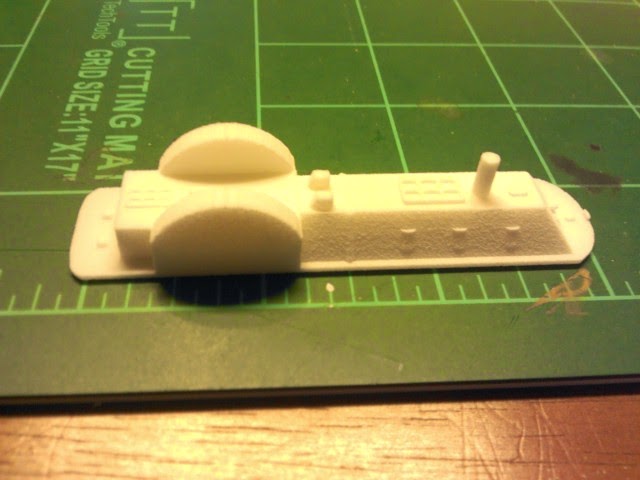At the end of April 2015,
Black Army Productions BAP unveiled their new line of 1:600 miniatures of warships of the American Civil War. Those that know me and/or read this blog know that I am a sucker for 1:600 warships - especially when the subjects are obscure models rarely produced by anyone else!
BAP has selected to produce this range using Shapeways 3D printing on demand services. You want one, you order it. Shapeways prints the design and ships it to you. No muss, no fuss. 3D printing is rapidly becoming the "shape of things to come" for miniatures production. The technology is rapidly advancing both in printer resolution and printing materials. This medium works well for certain aspects of the hobby. I'd ordered two 1/600 models last year from a different designer on Shapeways and was less than impressed with the
'stuccoclad' and USS Monitor.
But as I say, this technology keeps rolling along. I perused the list of products available on the
Infernal Machines storefront. The investment was not too steep, so I placed an order for two unique models not otherwise available - The Yazoo Monster and CSS Barataria. I took the BAP team's recommendation to order both models in Black, Strong and Flexible as they suggest it has a smoother texture than the standard White Smooth and Flexible (cost an addition $1.00 per model) The models arrived after several weeks - unusually slow for Shapeways, but it might speak to the demand for the BSF material and print runs. Regardless, it's not something BAP can control - the delay was all Shapeways.
So the models arrived on my doorstep. Opening the box, I found my two models. The
Yazoo Monster lives up to it's name - It's a beast! One of the great things about 3D printing is that the model is a single piece. Hull, casemate, paddle wheels and stacks all one single piece. No assembly required! Try doing that with the conventional casting methods and see what happens! Size wise, we are talking about a model in the same size range as CSS Nashville. It's similar construction as well, with a number of key differences. For instance - three smokestacks!
![]() |
| The Yazoo Monster (the black blob) lined with with Thoroughbred's USS Choctaw and Bay Area Yards USS Dunderberg gives you a good comparison of the relative size of the models. |
![]() |
| Here The YM is in the middle with Dunderberg and the BAY CSS Missisippi model. |
|
|
The model is surprisingly smooth when printed in Black Strong and Flexible. It's a far superior medium than White Strong and Flexible and worth the extra dollar. Any of you that have worked with WSF and gaming models will appreciate the improvement that BSF offers.
![]() |
| This close up shows some of the surface detail (or lack thereof). My biggest worry was it would be a 'stuccoclad'. That turns out not to be the case - this should paint up nicely! |
![]() |
| Bow aspect of the model. The forward gun ports are modeled, but lack any sign of the gun barrel or a shutter. Given the limited details available, I'm fine with the depiction on the model. |
![]() |
| Okay - so this thing is tough to photograph in black! Mea culpa! But you get a sense of the size. |
Now for the sticklers out there, the detail. I'd place this model on the continuum of being between
Bay Area Yards and Peter Pig for detail and quality. The model has decent game table details - pilot house windows and gun ports are cleanly modeled. The deck and armor do not reflect the engraved detail you get from
Thoroughbred or
Bay Area Yards. But you know what? That's okay. This model should paint up very nicely.
The second model is
CSS Barataria. This is another obscure ship that is not available in 1/600. It's so obscure that little information is readily available regarding this ship. It apparently carried some form of armor over the boilers and mounted a gun. A stern wheeler, she was captured by the US Navy and served as a Union ship for the remainder of the war.
![]() |
| CSS Barataria |
![]() |
| A one piece model, the stacks are a little fragile, but the wheel was already assembled! |
The model has a very narrow beam. It's comparable to the beam on a
Thoroughbred blockade runner model. The wheel looks like it would be better suited on a mill pond than a river boat. The model is small - about the size of a Thoroughbred tug boat or the
BAY Naugatuck models.For a model this small, it's maybe a
tiny bit pricey, but you
are getting a unique model available from now one else.
![]() |
| Bigger than a tug, but smaller than USS Fuschia from Peter Pig. |
![]() |
| Here is Barataria next to a Thoroughbred blockade runner for comparison. |
My verdict: Good solid gaming pieces! I'm happy to use both on my gaming table with the rest of the collection. The detail is not at the high end work done by Thoroughbred or
Bay Area Yards, but I'd class it as a "show" in the classic "Win-Place-Show" ranking of a horse race. I'll be keeping my eyes on these guys in the future!
















